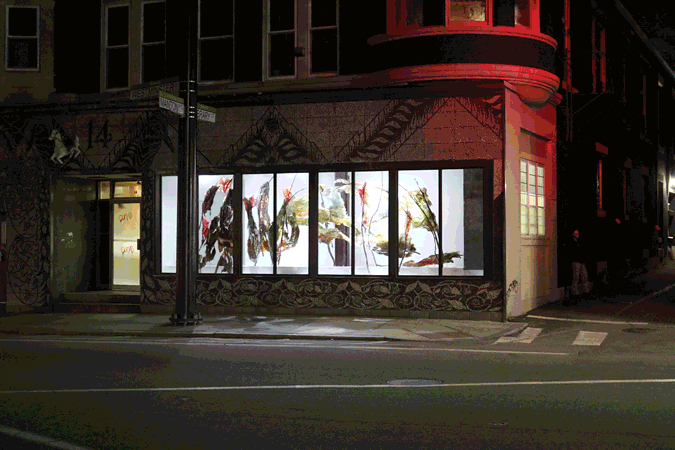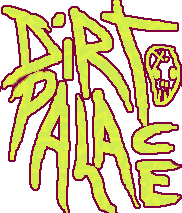| ||||
| ||||
Friday, July 24, 2020
Window Gallery - Kah Yangni & Keegan Bonds-Harmon
Friday, July 17, 2020
Interview with Kah Yangni
Kah Yangni is an artist, illustrator, and muralist living in Philadelphia. Kah lived in Providence from 2009- 2019, and it was a pleasure to have them come back to PVD to do a mural in the Storefront Window Gallery.
Pippi: Your installation in the Dirt Palace Storefront Window Gallery quotes a song on the Solange album “Seat at the Table”, can you talk about the piece and your relationship to the lyrics?
Kah: I love that album so much. “A Seat at the Table” is an album long meditation on Solange’s blackness and her womanhood. I listen to it a lot. In the months before I came to do this mural, I would play this tiny song called “Interlude: I Got So Much Magic, You Can Have It” over and over and over.
The full lyrics of the interlude go: “you did it from the get go, get go, get go / let’s go, let’s go, let’s go / look for magic, ye-ah / they not gonna get it from the get go, get go, get go / don’t let, don’t let, don’t let / anybody steal your magic, ye-ah / But I got so much, y’all / you can have it, ye-ah.” It’s just three women singing acapella for less than thirty seconds.
To me the song is about how we have a magic that often isn’t recognized- and that even if it’s recognized and people try to steal it from us, it’s okay, because we have so much of it that we’ll be okay.
June was crushing. Every day was a flood of news about black people dying or people fighting against black people dying. I knew I wanted to do something that would be like a message in a bottle to anyone black or brown who passed the mural, to lift them and make them feel good at a time that was really dark.
P: How does music inspire or tie into your visual work? You sometimes use song lyrics in your illustrations and murals (along with quotes from activists) and as inspiration (I’m thinking of your shoebox Pride parade float for Vice inspired by Janelle Monae’s “Pynk”), and you are also a musician. I watched an interview where you talked about organizing Pronk! And your relationship to bringing people together through celebration. I’m curious if you see a connective thread between these different formats and mediums in which you work.
K: I love music! I have headphones on all the time, listening to podcasts or music. If I feel insecure, I listen to “Django Jane” or “Electric Lady” from Janelle- those songs are powerful, so for 2-3 minutes I’m sucked into the feeling of being powerful. I definitely feel like being a musician is a chance to literally embody a feeling. I’m a quiet person but as a musician I’m super loud! I can be covered in glitter, I can take my horn and start a party in an alleyway.
A music show or fest changes the culture for as long as it’s happening, but then it goes away. But visual art you can see and it can be with you all the time. A mural on a wall can last for years and years, and can change how people act around it. My overall artistic goal is to affect the culture in places the way a really good show does. So I am working to become a super strong visual artist and push myself to spread the work and make it large scale.
P: Your illustrations have an intimacy and care that feels deeply embodied…. I’m wondering about scale and how your work might shift when you’re creating something super large scale - like a mural. I’m setting this up like they would be oppositional - and I don’t think that’s the case - but I’m thinking about how your body exists in relation to the work when making something that’s small and maybe can be held in the hand (like a print) versus a large scale painting.
K: I’m trying to do the exact same thing but affect a greater number of people.
I put on my artist brain when I am designing the mural, and that feels the same whether I’m planning a mural or a print. I get to enjoy flow state. But painting a mural feels more like being a contractor.
Making murals is actually super physically uncomfortable. In the northeast, outdoor mural season is late spring through early fall. That means it’s hot and muggy. Maybe you’re sore from climbing ladders; you deal with people outside who are mostly nice but sometimes not; maybe someone peed near a wall you have to paint. But it is worth it because when you make giant art, you have the opportunity to change the energy of the space around that mural and make people think differently not only about themselves but about that block or that city even.
Xander: Print nerd question: you rock the rainbow roll a lot in your screen-printing work! In my experience with screen-printing I find that sometimes I do this out of a sense of efficiency (it can make a one or two color print way more colorful) but sometimes because I just want to experiment as I go and make each print a little different. Is your use of the rainbow roll related to either of these or something else altogether? It also seems like a natural extension of your work with watercolor. Can you talk a bit about how you think about screen-printing and how it connects with the other media that you work with?
P: You recently illustrated the National Women’s Law Center project, Brick by Brick, an advocacy curriculum that centers the experiences and identities of LGBTQ+ students of color designed for middle school and high school students. Can you talk about Brick by Brick, and your experience working on the project?
K: It was so funny to work on. I’m not even the target audience but I read it and felt like I was learning a lot.
I’m 29 years old. I have been out of the closet for more than ten years. But so much of what I learned from the curriculum, I learned for the very first time! I had never heard of almost any of it.
I read about these people in gay history and I felt like I was seeing myself and all my gay friends as we were moving through our twenties. We’re not weird- we’ve existed for a long time. We have our own history to be proud of. We’re real.
P: The illustrations in the Brick by Brick project are so multi-layered. They look like a combination digital, text, and hand painted scanned pieces.Can you talk about your process in creating these illustrations? Did you start with the text? The images? Did research play a part in creating these works?
K: I just started with reading the curriculum- clicking through all the links, watching all the videos. Then I started by drawing the people and the quotes by hand, on paper. I would paint pieces of paper with watercolor and take big sheets of screenprinted color and scan it all into the computer. Then I would use photoshop to combine and arrange it all. A little bit like a digital collage!
X: When landing on your website the phrase “I love art and what happens to people when they make it” comes up. This resonated a lot….locating a potential for change inside of the creative process. Then I quickly come to the print piece that features the text “Trans is freedom, is adventure, is endless”. These two sentiments, particularly when I hold them together offer a vision into change that is poignant. These two phrases say a ton already, but I wonder if you would be willing to share ways that art, change, and gender/identity and openness have intersected on your path.
K: I love this question! To me, being trans means I get to be creative with myself. Expression is super fun! It’s like a game or an adventure. I think that’s why you see a lot of trans and queer people allowing themselves to be more flexible with the way their families and relationships and lives look- because being queer in the first place, a lot of the time, is kind of creative. There isn’t a strong map that’s hundreds and hundreds of years old of what to be (like there is a map of how to be straight or be cis) so you create yourself a lot.
Making art is the same way- you make something totally new, and then it’s like you made a shift in the world. You can do things differently. It lets you know that you can build what you want.
Subscribe to:
Posts (Atom)














